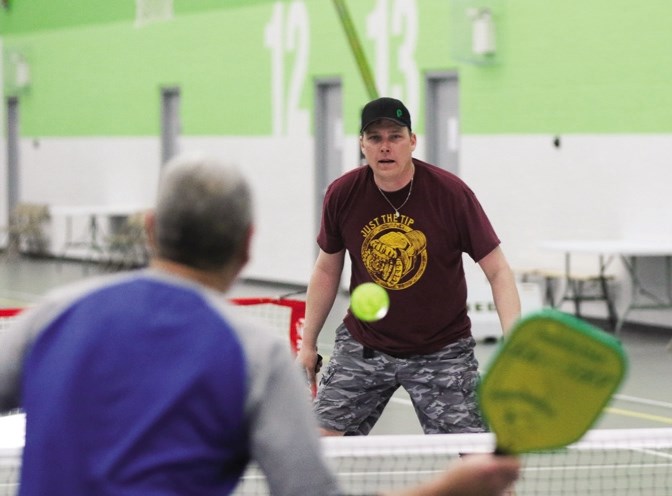The Crescent Point Regional Field House is near capacity, but operators are still looking to increase its usage one year after opening its doors.
MD and Okotoks councils received 2015 year-end reports from the Foothills-Okotoks Recreation Society in the past week. In January and February of this year, the facility ran at an average of 82 per cent capacity during peak hours – evenings and weekends – nearing its maximum of 90 per cent.
“That’s a great number and that’s exactly where we want to be,” society secretary Andrew Gustafson told MD council.
He said the usage rate cannot exceed 90 per cent, because it allows for 10 minutes between games to change out teams on each field. He said shrinking that gap would not be ideal for groups and teams. More than 20 groups use the facility on a regular basis and some are a surprise.
“For example, the Stampede Show Bands,” he said. “I don’t think anybody really had that in mind as a potential use for the building, but they come here and they practice their marching during the winter.”
The show bands were featured on a segment of the Rick Mercer Report on March 1, giving more attention to the Crescent Point Regional Field House and its range of uses, he said.
Pickleball and Foothills Minor Softball for winter camps are also unexpected users of the field house.
Greg Muir, director of player development for the organization, said the field house has allowed its winter session to move out of small school gyms, where drills were restricted.
“We can do drills that really benefit skill development,” said Muir. “We can set up a regulation-size infield for throwing and running and we get more realistic bounce off the surface for fielding drills.”
He said the success of teams last year – two city championships and one silver medal at provincials – was a direct result of having access to a proper training facility during the winter.
The only downside, he said, is the field house can be difficult to book due to its popularity.
“We have such a great facility, but it’s so jam-packed,” said Muir. “We’ve already booked our 2016-2017 winter ball sessions and even at that there were already some dates we couldn’t get.”
Okotoks Raiders Lacrosse Association (ORLA) and the Okotoks United Soccer Association also report the field house has made a positive impact for the clubs.
Randy Landymore, president of ORLA, said more floor space for lacrosse has meant being able to host winter camps in Okotoks instead of having players train in Calgary.
In addition, he said the extra playing surfaces make it easier for the league to run its regular season. With more than 20 teams and close to 300 players, having sufficient space is crucial, he said.
“Having three floors was enough for us to schedule and run our season, but the ice wouldn’t come out until the end of April or so,” said Landymore. “Evaluations and camps had to move to Calgary, but having the field house allows us to do those things here and start our season on-time.”
For soccer club Okotoks United, the field house has made more than just an improvement to scheduling – the club saw a 92 per cent increase in the number of indoor soccer players in its winter league when it made the move to the field house in 2014. The 2015 season saw another 20 per cent increase above that.
Technical director Matt Lamsdun said being able to offer indoor soccer on proper local fields made all the difference.
The recreational league used to play in school gyms, but now runs from 9 a.m. to 2:30 p.m. on Saturdays at the field house, with close to 400 players registered from U4 to U16.
For the competitive teams, access to the field house means having a home field rather than always commuting the 35 minutes to Calgary’s south indoor soccer facility.
“The field house has given us a home, where teams come together to train, coaches and players get to know each other across all levels,” said Lumsden. “We’ve really become more of a club.”
He said the field house also allows Okotoks United to be one of few soccer clubs in the province to host major tournaments, like the provincials tournament that took place from March 11 to 13.
The league also put on its first major tournament, the United Communities Cup, in the fall with 66 teams and more than 1,200 players.
“We are now one of very few organizations to host indoor tournaments,” said Lumsden. “Now that we have the space and the capacity to do so, we plan to make ours a flagship tournament in Alberta for years to come.”
Gustafson said despite regular use by local sports clubs, the challenge now is finding ways to increase non-primetime utilization, during weekdays and in the summer when sports like soccer and softball move outdoors.
Offering activities like bubble soccer and birthday rentals are among those auxiliary uses, he said.
“That’s the question that comes up consistently, is what are the other ways that we can bring revenue in,” said Gustafson.
Ryan Payne, director of community services for the MD of Foothills, said roller skating or inline hockey could be potential user groups in the future, as the soccer surface can be rolled away, leaving a cement surface.
He said the society is also looking into a range of different events for the summer, including farmers markets and trade shows.
“There’s a large space here that’s not being fully utilized, but there are opportunities to look at those types of events and hosting more of them into the future,” said Payne.




